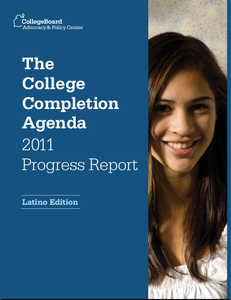LatinaLista — In 2008, the Commission on Access, Admissions and Success in Higher Education got together to review the educational status of Americans. What the commission saw disturbed them.

The US was falling behind other industrialized nations in the number of adults who had post-secondary degrees; more students were dropping out of high school and college and there was a growing achievement gap for low-income and minority students.
The commission decided to create a goal: Strive for 55 percent of the nation’s young adults to attain an associate degree or higher by 2025.
To achieve that goal, the commission knew there would have to be regular measurements conducted on different populations to see how they were doing with meeting the 2025 goal.
It seems Latinos are faring the worst of all ethnic and race groups.
Nationally, the community college and university graduation rates stand at 41.1 percent. Not a great number considering where the United States wants to stand when it comes to global competition but it’s a lot better number than the 19.2 percent completion rate among Latinos.
According to a new study released last week by the College Board Advocacy & Policy Center, and based on the commission’s original recommendations, a real educational crisis continues in the Latino community when it comes to higher education — and it is getting worse.
The College Completion Agenda: 2011 Progress Report Latino Edition offers a detailed analysis of today’s “educated” Latino population.
For example, from the report we learn that Peruvians are the group with the highest number who have gone or attained a college degree. The lowest group is Guatemalans. More Latinas than Latinos are attending college. Those who speak only English are getting college degrees at higher rates than Latinos who speak English “very well” or “with difficulty.” And the percentage of Latinos across the age spectrum of 24-64 years old rank the lowest among all ethnicities and races for attaining an Associate Degree or higher.
The report wasn’t created to regurgitate old news but to sound the alarm even stronger that something needs to be done.
The report’s authors say: “Limited educational attainment stifles both economic opportunity and social mobility, and if efforts are not taken to turn around these educational outcomes, there will be serious implications for the economic future of the nation.”
The commission outlined a ten-action program to improve the chances of more students going to college. The recommendations are:
- Provide a program of voluntary preschool education, universally available to children from low-income families.
- Improve middle and high school college counseling.
- Implement the best research-based dropout prevention programs.
- Align the K-12 education system with international standards and college admission expectations.
- Improve teacher quality and focus on recruitment and retention.
- Clarify and simplify the admission process.
- Provide more need-based grant aid while simplifying the financial aid system and making it more transparent.
- Provide more need-based grant aid while simplifying the financial aid system and making it more transparent.
- Dramatically increase college completion rates by reducing drop out rates.
- Provide postsecondary opportunities as an essential element of adult education programs
Unfortunately, the poor economy and xenophobic legislation passed throughout the country has derailed some of the potential targets laid out for Latino students. However, the report, along with, a dedicated web site tracking Latino student success, keeps the issue of why it’s important for Latinos to succeed in school in the forefront of the national conversation — and hopefully top-of-mind among legislators and policy makers looking towards the future.




